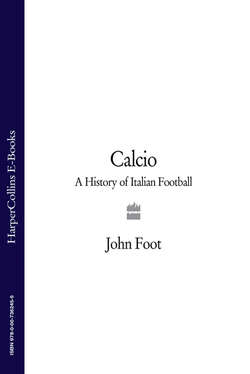Читать книгу Calcio: A History of Italian Football - John Foot - Страница 42
Legnano-Bologna, February 1952
ОглавлениеIn 1952 Legnano, a team from a small industrial town just outside Milan, were enjoying a rare spell in Serie A. The ‘Lilacs’ were at home to Bologna and desperately needed a win on an icy pitch. The referee was Bruno Tassini, from Verona. It was a dramatic game. Tassini first failed to send off a Bologna player after he had punched an opponent. He then refused to give two ‘clear’ penalties to Legnano before awarding a spot kick to Bologna, in the eighty-seventh minute, with the score at 2–2. The home crowd were incensed. Snowballs and cushions rained down from the terraces, and there was a minor pitch invasion. Tassini’s reaction was to call the game off – according to the press he simply ran off the pitch – making it inevitable that Bologna would be awarded a 2–0 win under federation rules. Newspaper reports blamed Legnano’s ‘defeat’ fairly and squarely on the referee. For the Corriere Lombardo Tassini had not respected the rules of the game and had ‘falsified the result’. The paper hoped that it had been Tassini’s ‘last match’ in charge. La Gazzetta dello Sport led with the headline ‘Tassini defeats Legnano’.
After the game, some fans wanted more. The referee was a marked man. First, he was attacked in a bar in Legnano, where he claimed that his dentures were damaged. He then made his way to Milan for dinner with various officials. As he walked towards the Central Station to catch a train home, two cars drew up and six or seven young men jumped out. They announced that they were Legnano fans and set upon Tassini, who was saved by his linesmen. The referee was hospitalized and ‘lost some teeth’ (although it is unclear what had happened to his earlier broken dentures). The youths were arrested and charged whilst the majority of Legnano’s supporters were still furious about the game itself. They travelled to Milan for a demonstration the next day, holding banners which read ‘Forty years of passionate support betrayed’ and ‘Sport is dead in Legnano’. Many were factory workers in their blue overalls.
These protests were in vain. The league threw the book at Legnano, banning them from playing at home for eleven months (for the rest of 1952). The official report claimed that ‘from the start’ the local fans had been ‘hostile’ to the referee, and that objects had been thrown at, and had hit, Tassini. The referee had also been struck and kicked on his way off the field and in the bar. Finally, there was the attack near the station, at 11.30 p.m. Legnano were held responsible for the whole affair and finished bottom of Serie A, with a mere seventeen points. They came up the next season, and then promptly went down, and have never again played in the top division. Tassini, meanwhile, went on to be a very important figure in the referees’ association in the 1960s.
